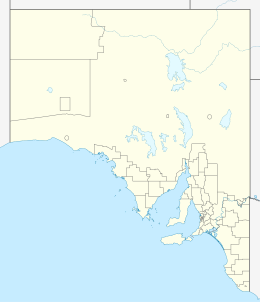Dangerous Reef

Dangerous Reef, near Pt. Lincoln, a bird colony and seal habitat. Circa 1932.
(State Library of South Australia PRG PRG-458-1-1-9) |
|
| Geography | |
|---|---|
| Location | Spencer Gulf |
| Coordinates | 34°49′03″S 136°13′03″E / 34.81744479°S 136.21747697°ECoordinates: 34°49′03″S 136°13′03″E / 34.81744479°S 136.21747697°E |
| Area | 12 ha (30 acres) |
| Highest elevation | 3 m (10 ft) |
| Administration | |
|
Australia
|
|
| Demographics | |
| Population | 0 |
| Coordinates | |
Dangerous Reef is an island and reef system located in Spencer Gulf in the Australian state of South Australia about 32.5 kilometres (20.2 mi) east-south east of the city of Port Lincoln. It is the southernmost member of the Sir Joseph Banks Group. It has been the site of a navigation aid since 1911. It is notable as the site of a breeding colony of Australian sea lions. The waters adjoining its shore are notable as a place to view great white sharks to the extent that it was both a popular gamefishing and shark cage diving venue during the twentieth century, and was used to film footage for the following motion pictures - Blue Water White Death and Jaws. The island has enjoyed protected area status since 1900 and it has been part of the Sir Joseph Banks Group Conservation Park since 1989.
Dangerous Reef is located in Spencer Gulf about 32.5 kilometres (20.2 mi) east-south east of the city of Port Lincoln, about 17 kilometres (9 nmi) north-northeast of Observatory Point on the northeast coast of Thistle Island and is about 17.5 kilometres (10.9 mi) east of the nearest point of the mainland on the Eyre Peninsula. Officially, it is described in one source as being a “reef.” In another official source, it is considered to be an island as it is listed as being part of the island group known as the Sir Joseph Banks Group despite being located about 15.5 kilometres (9.6 mi) south-southwest of Stickney Island, the nearest group member. Dangerous Reef itself is described as consisting of “a chain of four large rocks” with the tallest reaching a height of 3 metres (9.8 ft) with the remainder being “barely dry” at low tide as well as some other “small rocks.” At high tide, the island/reef system has an area of dry land covering about 12 hectares (30 acres) while at low tide, the system dries to an area of about 40 hectares (100 acres). Access to the island/reef system which is subject to permission by the responsible government agency due to the island group’s protected area status (refer below) is either via boat or helicopter.
...
Wikipedia

